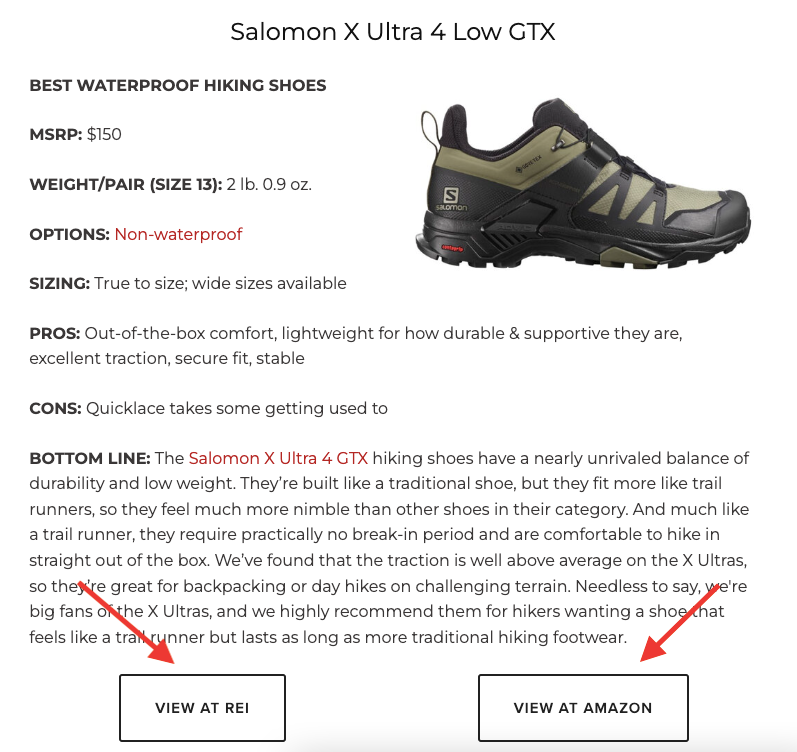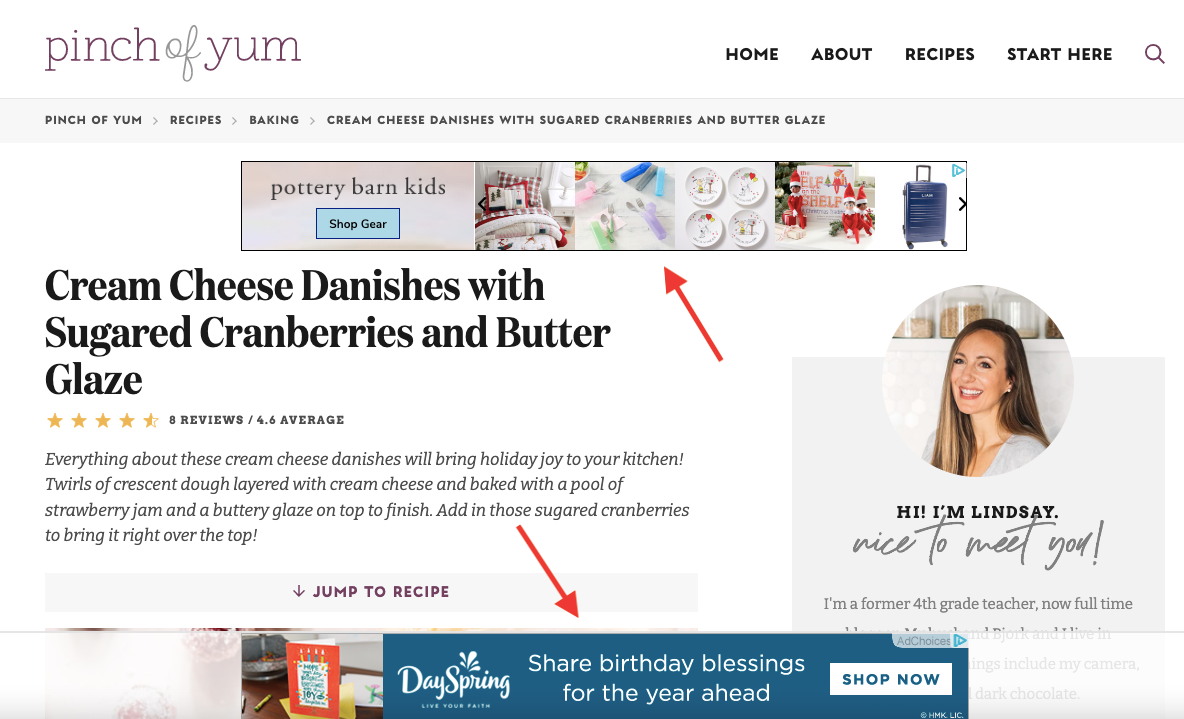If you’re looking to build a niche website, but don’t know where to begin, this article is for you. Starting a niche website from scratch can seem like a daunting task, but it doesn’t have to be.
We’re going to walk you through exactly what a niche website is, why you might want to start one, and the exact steps you need to follow to get up and running.
Ready to get started? Let’s go.
What is a Niche Website?
A niche website is a site that focuses on one specific topic, industry, or audience. Niche websites can be about anything, from hunting to fashion to finance. The key is to find a topic that you’re passionate about and then build an audience around it.
Think about some of the websites you visit on a regular basis. Do they focus on different types of topics or are they hyperfocused on being an expert in one thing? If you answered that they’re hyper-focused, then that would be a niche website.
Examples of Successful Niche Sites
Need a couple of examples to really understand exactly what successful niche websites look like? Here are a few examples:
Wirecutter
If you’ve ever wanted to learn more about a particular product, you’ve probably stumbled upon WireCutter. They’re one of the oldest and most profitable niche websites. Most of their revenue comes through affiliate programs. Not too long ago they were even purchased by The New York Times.
CleverHiker
The CleverHiker is a niche site that focuses on outdoor adventures. You’ll find content on everything from the best hiking shoes to the best camping tents. Dave and Annie, who founded the site in 2012, are primarily monetizing the project through different affiliate programs.
Pinch of Yum
If you’ve ever been in search of a good food recipe, you might have stumbled upon the food blog, Pinch of Yum. Not only do they have a huge amount of delicious recipes but as an extremely successful niche site, they’re making a lot of money each month through display advertising and sponsored content.
They also started Food Blogger Pro which is a membership site that gives people the tools needed to build their own niche website in the food space. It’s a great way for them to generate revenue from a different source.
The Golfing Dad

If you’re a golfer, have you ever wanted to find out what the best driver on the market is? How about the best golf bag? The Golfing Dad is a niche site that not only publishes helpful tips to help you improve your golf game but also reviews some of the best golf products. The site is monetized through Amazon as well as other affiliate programs.
How Much Can You Earn From a Niche Website?
Most people decide to create a new niche website because they want to make money online. So the obvious question is exactly how much can you make from a successful niche site. The answer really depends on a number of things.
The biggest variable is going to be the niche you choose. Some affiliate sites in the finance niche or software as a service (SaaS) will give you the chance to earn significantly more than a niche site about comic books. The reason is that advertisers in each of these niches are willing to pay more to gain new customers.
Above I mentioned the food blog, Pinch of Yum. Several years ago they were providing income reports for how much the blog was making each month. Most of the income came from ads and sponsored content, but as a whole, the site was earning nearly $100,000 per month.
Another incredibly successful niche site called Smart Passive Income was started by Pat Flynn more than a decade ago. It’s been several years since he published an income report, but in December 2017 his gross income was $167,000.
Is that going to be realistic for everyone? No, probably not. Your earning potential will depend on the time and effort you put into the site. It’s also going to be easier to make money from a niche website that’s not in a super competitive niche.
However, it’s reasonable to think you can start earning affiliate income within the first few months and potentially earn $1,000 or more within the first year of starting your niche website.
7 Steps For Building a Profitable Niche Website
Now that you have a little background about what a niche site is, let’s get to the good stuff.
We’re going to walk you through exactly what you need to do, step-by-step, to set up your own niche website.
1. Choose Your Niche
Your ability to earn money from your niche site is going to depend greatly on the niche you choose. As we mentioned earlier, some niches are going to provide the opportunity to earn more than others.
Remember, your chosen niche shouldn’t be just about the money potential. It needs to be something you’ll be passionate about.
That being said, start by writing down a few niche site ideas you enjoy. Maybe you love to play golf or you have an interest in real estate investing. The list you build is going to be a good starting point.
Now it’s time to narrow down that list so that you can find the perfect niche site idea.
Take each item on your list and ask yourself the following questions.
- Is the niche a current trend or is this something that will be relevant for years to come?
- Are there a good number of brands with affiliate programs within the niche?
- Are those brands offering good commission rates that will give you the opportunity to make money online with your niche site?
If you answer no to the first question and yes to the other two, then that will be the perfect niche to build a website around.
2. Build Your Niche Website
Now that you’ve picked out your niche, it’s time to actually build your niche website.
Pick a Domain Name
Start by picking out a domain name to use. The key is to pick out a name that people will remember and that you can build a brand around. If possible, try and find something that is a .com domain.
One misconception floating around is that a domain name needs to include a keyword. Google is smart. They can understand what a website is about. You don’t need to spend hours finding a name that includes a keyword.
Once you’ve come up with a couple of domain name possibilities head over to a domain register like GoDaddy.com to see if they’re available. You can also register a domain name with the hosting provider you chose. We’ll talk more about that next.
Get Set Up With a Hosting Provider
Next, you need to get set up with a hosting provider. Bluehost is a great option for beginners. As you grow, you’ll want to move into something bigger and a little more robust. One of my favorite hosting companies right now is InMotion. They have very affordable VPS plans.
Choose a Theme
Once you’re all set up with the backend, you’ll need to start building the niche website itself. Every niche website I’ve ever built has been built on WordPress. It’s by far the biggest and most popular content management system out there.
Once you’ve downloaded WordPress and it’s all set up. You’ll need to pick a theme. The theme is going to be where you customize the front-end part of the website. This is what the users will see.
There are a lot of great website themes available today, but a few great companies are Astra, Kadence, and Elegant Themes.
3. Start Researching The Competition and Understand the Potential
Now that you’ve got your website set up, it’s time to start building it out with great content. Understanding and analyzing your competition is going to be critical for your success.
For this example, let’s set up a niche website about kayaks. Kayaking can get pretty expensive. Some higher-end kayaks can sell for well over $1,000.
Using Semrush we can do a quick search for “best kayak” and see that there are 2,900 monthly searches. That’s not a lot for a broad, competitive keyword, but if we look at some keyword variations, there is less competition and more search volume.
While you might not be focusing your efforts on competitive keywords like “best kayaks”, there are more than 17,000 keyword variations that account for more than 229,000 searches each month. That tells you that there’s a lot of opportunity for this particular niche website.
Who is Your Competition?
As you start your keyword research, dig into some of the long-tail keywords that are much easier to rank for. From there, you’ll find some of your competitors.
Here are a few that I spotted along with their monthly traffic numbers:
- PaddlingSpace – 64,400 monthly visitors
- Kayak Paddling – 25,800 monthly visitors
- Water Sports Wiz – 145,000 monthly visitors
Let’s dive a little deeper into the niche website Kayak Paddling. Looking at their top organic pages, you’ll notice that they’re nearly all comparison articles. They’ve put together articles that walk their readers through the best fishing kayaks with motors, the best trolling motors for kayaks, the best kayak trailers, and more.
These types of pages are great for monetizing with Amazon affiliate links or through other good affiliate programs. People know they want to buy a product, they just need a little help figuring out which one is best for them.
If you’re building your niche website with affiliate monetization in mind, comparison, head-to-head, and review articles are going to be where you’ll make a lot of your affiliate revenue.
How Much Money Can You Make?
Just like anything else, there is a wide range in pricing for kayaks. Some introductory models can be $300 or less. However, the nicer the kayak, the more expensive they become. Some can even cost $5,000 or more.
If you’re planning to monetize your niche site through affiliate marketing, you have several options to choose from.
- Sportsman Warehouse – 3% commission
- REI – 5% commission
- Cabela’s – 3% commission
- Amazon – 3%
So how much income can you expect to earn for each referral? Let’s assume you refer someone to Sportsman Warehouse and they purchase a $1,200 kayak. You’ll earn $36.
4. Start Doing Your Keyword Research
Now that we’ve identified other sites in the niche and looked at how they’re generating their organic traffic, it’s time to dive in and come up with a keyword plan of our own.
When it comes to finding the best keywords, keyword research tools are going to be your best friend. They’re going to make the whole process go faster and more efficiently.
I’ve used several tools over the years but Semrush is my favorite all-around tool. Not only can you do keyword research, but you can dig into your competitor’s keyword strategy like we just did. It’s not cheap, but for just over $100 a month, it’s going to give you all the data you need to start a successful niche website.
To get started you’re going to want to build a list of some of your core money-making keyword ideas. These would include the following:
- Comparison Keywords – Comparison keywords are going to drive traffic to roundup-style articles. These will compare a handful of different products within a certain vertical. This could include, “best inflatable kayaks, “best sit on top kayaks”, “best tandem kayaks”, etc.
- Head-to-Head Keywords – These keywords will drive readers to articles where you compare two different products head-to-head. This could be “Perception kayaks vs Ocean kayaks”.
- Review Keywords – This will be where you review individual products. This could include things like “Perception kayak review” or “Ocean Malibu 9.5 review”
People that are searching for any of these keywords are going to be further down the sales funnel than someone casually looking for kayaks. They know they want to buy a kayak, they’re just trying to determine the exact model.
Now let’s create a list of each type of keyword.
Comparison Keywords
Using the Semrush tool you’ll want to do the following to find a list of the best comparison keywords to target.
- Select Keyword Magic Tool
- Enter the root keyword “Kayaks”
- Choose Broad Match
- Click “Include” and enter the term “best”. This will make it so that only keywords that include the word best make it into this list.
- Filter the KD score so that it only shows keywords with scores from 1 to 29.
As you can see from the image there are a lot of long-tail keyword opportunities that have good search volume and lower competition. They are going to be the keywords that you want to create content around.
Head-to-Head Keywords
Next, you want to compile a list of all the head-to-head keywords you want to target. To complete this, you want to follow these steps.
- Go to the Keyword Magic Tool
- Enter different brands of kayaks as your keyword. This could include “Perception”, “Ocean Kayak”, and “Wilderness System”.
- Choose Broad Match
- Click “Include” and enter the term “vs”. This will provide you with a list of keywords that include the word vs.
- Filter the FD score to only show keywords with scores from 1 to 29.
Unfortunately, as you can see in the image above, there isn’t that much traffic for these head-to-head types of keywords in the kayak niche.
Review Keywords
The final group of keywords is going to be the review keywords. To discover these keywords, you’ll want to follow these steps.
- Go to the Keyword Magic Tool
- Enter different brands of kayaks as your keyword. This could include “Perception”, “Ocean Kayak”, and “Wilderness System”.
- Choose Broad Match
- Click “Include” and enter the term “review”. This will provide you with a list of all the branded reviews you can put together for different kayak brands.
- Filter the FD score to only show keywords with scores from 1 to 29.
5. Start Building Out Content
At this point, you’ve compiled a list of keywords that have good traffic potential and lower competition. Now it’s time to write quality content for your niche site.
This is going to be the most important part of your niche site. This is how you’re going to drive organic traffic and most importantly, where you’re going to implement your different monetization strategies.
Build a Content Strategy
As you start writing content there are a few things that need to happen. Making sure each of these is checked off will be the difference between building a profitable niche website and building one that never takes off.
- Your content must be focused on the right keywords.
- Make sure everything you write is going to be valuable to your readers.
- It must be well-written and free of grammar mistakes.
- You need to make it easy for people to read. Use short paragraphs and bullet points. This will help break up things and make them skimmable.
- Because you’ll be driving organic traffic, you need to make sure you’re answering the reader’s query. If they want to find out what the best kayak brand is, make sure you provide them with the best brands to choose from.
- Use images and videos where appropriate.
- Use a clear call-to-action to get people to click your affiliate link.
Writing Keyword Focused Content
Google is very good about understand the basic concepts of the content you write, but applying your main keyword within the article is still a must. Here are a few tips to consider:
- Your keyword should be used within the title of your article with an H1 tag.
- You should use the keyword throughout the article. The exact number of times depends on the competition. I use Surfer to help me analyze the competition to know how often I should be using different words.
- The keyword should be used at the beginning and also at the end of your article.
- Add H2 and H3 subheaders within your article that include keyword variations.
How Long Should Content Be On a Niche Site?
There isn’t really a set answer for how long each article should be. Some might be 1,000 words and others might be 4,000 words.
When I’m writing content, I decide the length based on the competition. If other websites ranking well for my keywords are writing at least 2,000 words, I want to do the same.
Just remember that however long your article is, you want the entire thing to be providing value for your readers.
Organizing Content
The content on your new niche site should be well organized. This allows people to find most content within just a few clicks. If you notice from this website, I have content broken into three categories.
- Digital Marketing
- Affiliate Marketing
- Blogging
I feel like the sweet spot for the total number of categories is between 3 and 5.
6. Monetizing Strategies For Your Niche Site
Before you start building your niche site (or niche sites) you might have a monetization strategy or two in mind.
Maybe you want to create a profitable niche website by promoting high paying affiliate programs. Maybe you want to use display ads. Or create online courses. Here are a few examples.
Affiliate Marketing

Earlier I mentioned the niche site CleaverHiker. They monetize their site through different affiliate programs and also Amazon Associates.
They’ve built out a bunch of comparison articles and in each of these, they provide readers with multiple ways to purchase products.
Display Ads

Another way to generate revenue from your niche site is to use display ads. Google Adsense is one option, but they’re generally a lower paying option. Another company you could consider is Mediavine.
One thing to know about adding display ads is that they typically require a large amount of traffic to generate a meaningful amount of revenue.
7. Link Building
While it would be nice if traffic started coming as soon as you published content to your niche website, that typically doesn’t happen.
At this point, you need to focus on off-page search engine optimization (SEO) and build links into the pieces of content you’ve published. These links are a signal to Google that this piece of content deserves to be ranked high and that it’s going to satisfy the user’s search intent.
There are a lot of ways you can do link building and we could write an article all by itself on the topic. However, some of my favorite link-building tactics include guest posting, broken link building, and getting earned media links through HARO.
The Bottom Line
Building a successful niche website isn’t as difficult as you might think. As long as you start in a good niche, choose low competition keywords, and have great content, you’ll be well on your way to building a successful niche website business.





